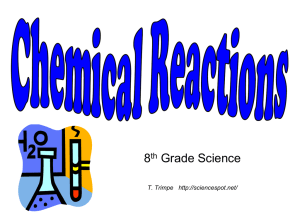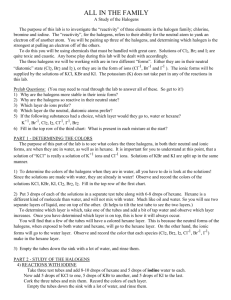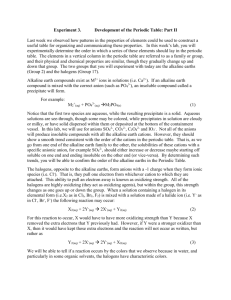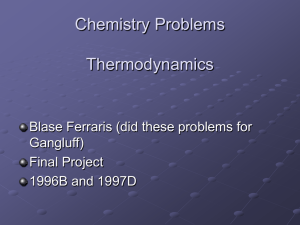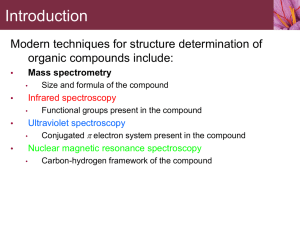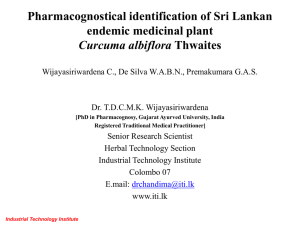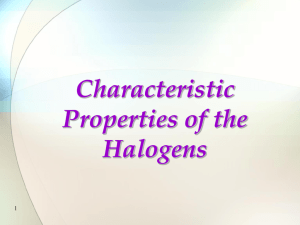Properties of the Halogens
advertisement
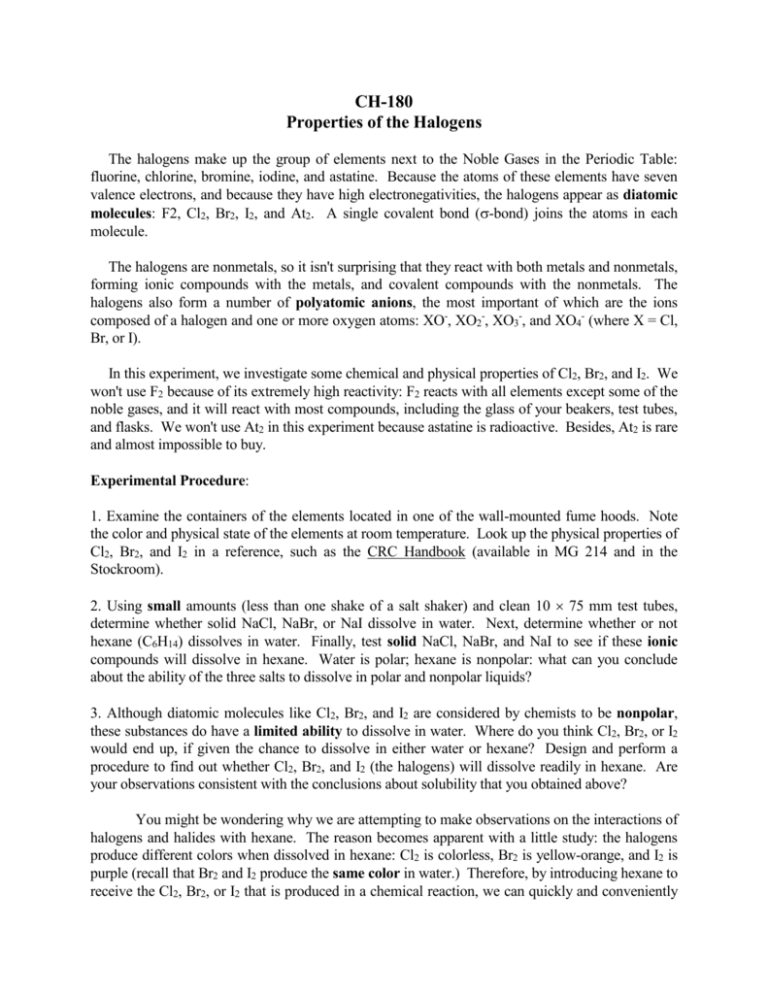
CH-180 Properties of the Halogens The halogens make up the group of elements next to the Noble Gases in the Periodic Table: fluorine, chlorine, bromine, iodine, and astatine. Because the atoms of these elements have seven valence electrons, and because they have high electronegativities, the halogens appear as diatomic molecules: F2, Cl2, Br2, I2, and At2. A single covalent bond (-bond) joins the atoms in each molecule. The halogens are nonmetals, so it isn't surprising that they react with both metals and nonmetals, forming ionic compounds with the metals, and covalent compounds with the nonmetals. The halogens also form a number of polyatomic anions, the most important of which are the ions composed of a halogen and one or more oxygen atoms: XO-, XO2-, XO3-, and XO4- (where X = Cl, Br, or I). In this experiment, we investigate some chemical and physical properties of Cl2, Br2, and I2. We won't use F2 because of its extremely high reactivity: F2 reacts with all elements except some of the noble gases, and it will react with most compounds, including the glass of your beakers, test tubes, and flasks. We won't use At2 in this experiment because astatine is radioactive. Besides, At2 is rare and almost impossible to buy. Experimental Procedure: 1. Examine the containers of the elements located in one of the wall-mounted fume hoods. Note the color and physical state of the elements at room temperature. Look up the physical properties of Cl2, Br2, and I2 in a reference, such as the CRC Handbook (available in MG 214 and in the Stockroom). 2. Using small amounts (less than one shake of a salt shaker) and clean 10 75 mm test tubes, determine whether solid NaCl, NaBr, or NaI dissolve in water. Next, determine whether or not hexane (C6H14) dissolves in water. Finally, test solid NaCl, NaBr, and NaI to see if these ionic compounds will dissolve in hexane. Water is polar; hexane is nonpolar: what can you conclude about the ability of the three salts to dissolve in polar and nonpolar liquids? 3. Although diatomic molecules like Cl2, Br2, and I2 are considered by chemists to be nonpolar, these substances do have a limited ability to dissolve in water. Where do you think Cl2, Br2, or I2 would end up, if given the chance to dissolve in either water or hexane? Design and perform a procedure to find out whether Cl2, Br2, and I2 (the halogens) will dissolve readily in hexane. Are your observations consistent with the conclusions about solubility that you obtained above? You might be wondering why we are attempting to make observations on the interactions of halogens and halides with hexane. The reason becomes apparent with a little study: the halogens produce different colors when dissolved in hexane: Cl2 is colorless, Br2 is yellow-orange, and I2 is purple (recall that Br2 and I2 produce the same color in water.) Therefore, by introducing hexane to receive the Cl2, Br2, or I2 that is produced in a chemical reaction, we can quickly and conveniently 2 know which halogen was produced. The hexane does not react with the halogens; rather, the hexane merely provides a place for the halogen to be observed. All of the chemical reactions take place in the water layer. 4. Now we will look at reactions between halogens (Cl2, Br2, I2) and halide ions (Cl-, Br-, I-). Our classroom theory suggests that the element having the highest electronegativity will be the one that gains electrons in a chemical reaction. So, what would happen if we mixed some chlorine water (a source of Cl2) with some NaI (a source of I-)? The reaction equation is: Cl2 + 2 I- 2 Cl- + I2 Do you see how the more electronegative chlorine atoms gained electrons to become ions, while the iodine atoms lost electrons? Now perform the following procedures, in order to see if the halogens and halides behave in a manner consistent with our theory's predictions. a. Into a 13 100 test tube shake together (use a clean cork!) 10 drops of 0.2 M NaI solution and 10 drops of hexane. Note the color of the hexane layer. Why is there no color? Now add 20 drops of chlorine water to the test tube. Stopper the tube and shake vigorously for 15 seconds. Record the color of the hexane layer. Why is the hexane now colored? We added chlorine water, but Cl2 is colorless in hexane as we observed in step 3 of the procedure. The Br- and I- ions were also colorless before we added the chlorine water. Look at the test tube with NaI in it. Compare the color of the hexane layer to the color of the hexane layer for iodine water, I2, in step 3 of the procedure. If a reaction occurred, the following equation would describe the reaction: Cl2 + 2 I- I2 + 2 Clb. Repeat the procedure for step 4(a), but use 0.2 M NaBr instead of 0.2 M NaI. Be sure to record the color of the hexane layer. Did you see evidence of a reaction? What reaction equation would describe the reaction, if one did occur? c. Repeat the procedure for step 4(a), but use bromine water instead of chlorine water. Here, the reaction equation would be: Br2 + 2 I- I2 + 2 BrDid you see evidence of such a reaction? Record your observations. Would the reaction be consistent with our classroom theory, with its emphasis on electronegativity? d. Mix NaCl solution and bromine water together, patterning your procedure after your work in step 4(a). Did you see evidence of a chemical reaction of Br2 with Cl- ions? Record observations. e. Repeat the procedure again. This time use 0.2 M NaBr and iodine water. Once again, write the reaction equation that would describe the reaction, if it should occur. Was there a reaction? Note the hexane layer's color. f. Finally, repeat the procedure again, using 0.2 M NaCl and iodine water. Was there a reaction? Note the hexane layer's color. 3 5. For many years, people have known that Ag can react with Cl , Br , or I to form silver halide salts: AgCl, AgBr, or AgI. Surprisingly, the salts aren't soluble in water. To chemists, the salts are very useful in analysis of samples for the presence of Cl-, Br-, or I- ions. Two properties -- color and solubility in ammonium hydroxide -- are used to tell the halide salts apart. + - - - a. Mix together equal volumes of 0.2 M NaCl and 0.2 M AgNO3 to make about 1 mL of solution in a 13 100 mm test tube. Do the same in a second test tube, using 0.2 M NaBr and 0.2 M AgNO3; and likewise in a third test tube, using 0.2 M NaI and 0.2 M AgNO3. Record the colors of the silver chloride, silver bromide, and silver iodide precipitates that form. b. Use about 1 mL of dilute (5 M) ammonium hydroxide solution per test tube to test the solubility of the silver salts in dilute ammonium hydroxide. If any of the salts fail to dissolve after shaking, add 1 mL of concentrated (15 M) ammonium hydroxide and shake well. Caution: use a fume hood for 15 M ammonium hydroxide! If any precipitates still have not dissolved, add another mL of 15 M ammonium hydroxide. Can you draw any conclusions about the salts' solubility? Record your observations and conclusions. 6. Obtain an unknown salt (NaCl, NaBr, NaI) solution from the stockroom window. Be sure to record the sample's ID number. Using what you have learned about halogens and halide ions in parts 3, 4, and 5, perform tests to let you determine which halide ion (Cl-, Br-, or I-) is present in your sample. Remember, two different tests leading to the same conclusion are better than one; three are better than two, etc. Be sure to record the procedure that you used. Return the 13 100 test tube in which the unknown salt solution came to the stockroom window after you clean it. 7. Use the report form provided to complete your report. 4 Electronegativity -- A Key Property in Chemical Reactions We've seen that atoms achieve lowest energy when the electrons are all in completely filled sublevels. But, reactions often occur between atoms that already have all electrons in completely filled sublevels. Why do these reactions occur? Well, the property of electronegativity provides us with an explanation. Electronegativity (en) is the tendency of an atom to attract electrons to itself. As a periodic trend (seen in the "Properties of the Elements" lab), the en increases from left to right across the Periodic Table's rows, and increases from bottom to top of the Table's groups. If a high-en element comes in contact with an element of lower en, the high-en element may be able to take electrons away from the low-en element. Question: Predict whether or not the following chemical species can react when placed together. Show your reasoning. a. F2 & Ca b. Cl2 & H+ c. Li & Na Reaction? Reaction? Yes Yes No No Reaction? Yes No d. Br- & Cl2 Reaction? Yes No The reactions described above are called oxidation-reduction reactions, nicknamed redox reactions. A redox reaction always involves the transfer of control of electrons from one chemical species to another. Electronegativity can explain ionic bonding, but we can also use electronegativity to explain covalent bonding: CH4 + 2 O2 + electrons equally shared CO2 + 2 H2O + unequal sharing of electrons The high-electronegativity O bonds with the lower-electronegativity C and H, so that electrons are attracted more to the O atoms than they are to C and/or H. Think of covalent bonding as a partnership: O seeks to be the majority partner, while C and H are content to be minority partners.
